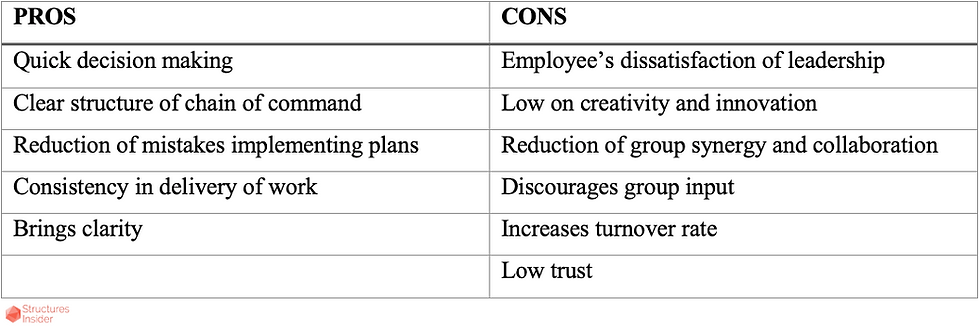Leadership style (McGregor's Theory X and Y)
- Structures Insider

- Dec 5, 2022
- 2 min read

Leadership styles
Leadership essentially can be described as a relationship through which one person influences the behaviour or actions of other people (Mullins, 2016). Leadership styles can be classified according to the way authority is used.
The authoritarian leadership style leans towards McGregor’s theory X and Taylorism. A consultative leadership style associated with the project-lead structure leans toward McGregor’s Theory Y and the managerial grid of Blake & Mouton (1964) which emphasises a more democratic, employee self-direction approach, focusing on motivating and having people at the centre. Some pros and cons of both authoritarian and consultative styles are listed in Table 1 and Table 2.
AUTHORITARIAN (THEORY X)

CONSULTATIVE (THEORY Y)

Action Centred Leadership (ACL)
The style and process of leadership are directly associated with the activities of groups and teams’ efficiency. The ACL as found by Adair (1973), highlights the core actions (see Figure 1) for effective leadership which is not based on any leadership style (MindTools, 2022).
The action by the leader in any of the core actions will affect one or both of the other actions, with the ideal position being when all three actions are integrated. These actions are grouped into achieving the common task, developing and meeting the needs of individual team members and building and maintaining the team.

Whilst the formal authoritarian style focuses more on the tasks, procedures and achieving business targets it is neglecting the needs of the group and individuals. The consultative style on the other side has a higher focus on the developing of the individual and building a well-functioning team however a lower focus is given to the task at hand.
Nevertheless, it should be pointed out by Fiedler’s Contingency Theory that there is no such thing as the ‘right style’ of leadership as it is based on the task that fits both the requirements of the leader and staff.
Contingency Theory Definition:
Contingency theory was introduced which looked at organisational effectiveness and looked at the best way to manage the organisation based on the task and manager fit. Pioneers of contingency were Lawrence and Lorch and Burn and Stalker.
Contingency theory suggests that there is no one best design of an organisation as it depends on the best fit between task and manager and the circumstances in which it operates. Depending on the tasks the situational leadership theory can be applied which states that as the level of maturity of the follower continues to increase in terms of accomplishing a specific task, the leader should begin to reduce task behaviour and increase relationship behaviour.
Get MULLINS Book
REFERENCES:
Mullins, L. J., 2016. Management and organisational behaviour. 11th ed. London: Pearson .
MindTools, 2022. Herzberg's Motivators and Hygiene Factors Learn How to Motivate Your Team. [Online]
indeed.com, 2021. 4 Types of Organizational Structures. [Online]
Harvard (HBS), 2019. 5 PROS & CONS OF AUTHORITATIVE LEADERSHIP. [Online]



